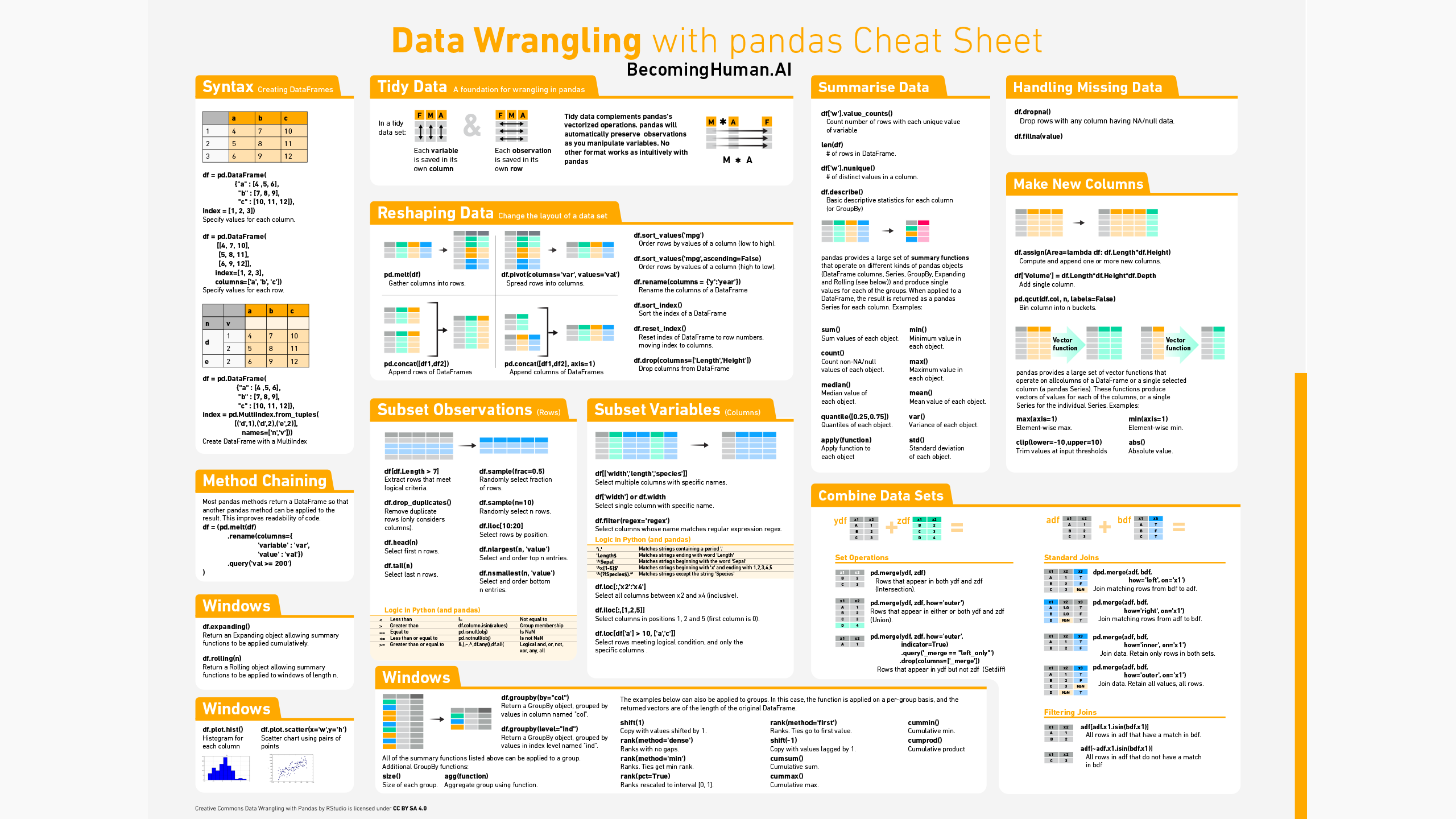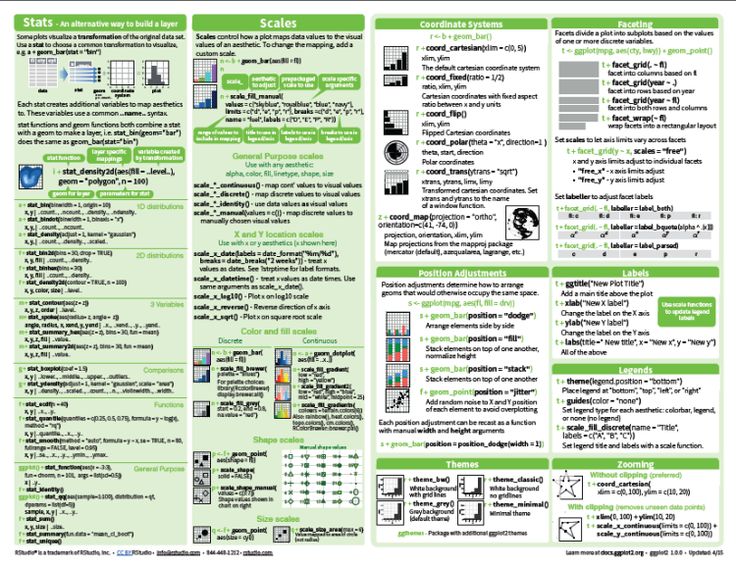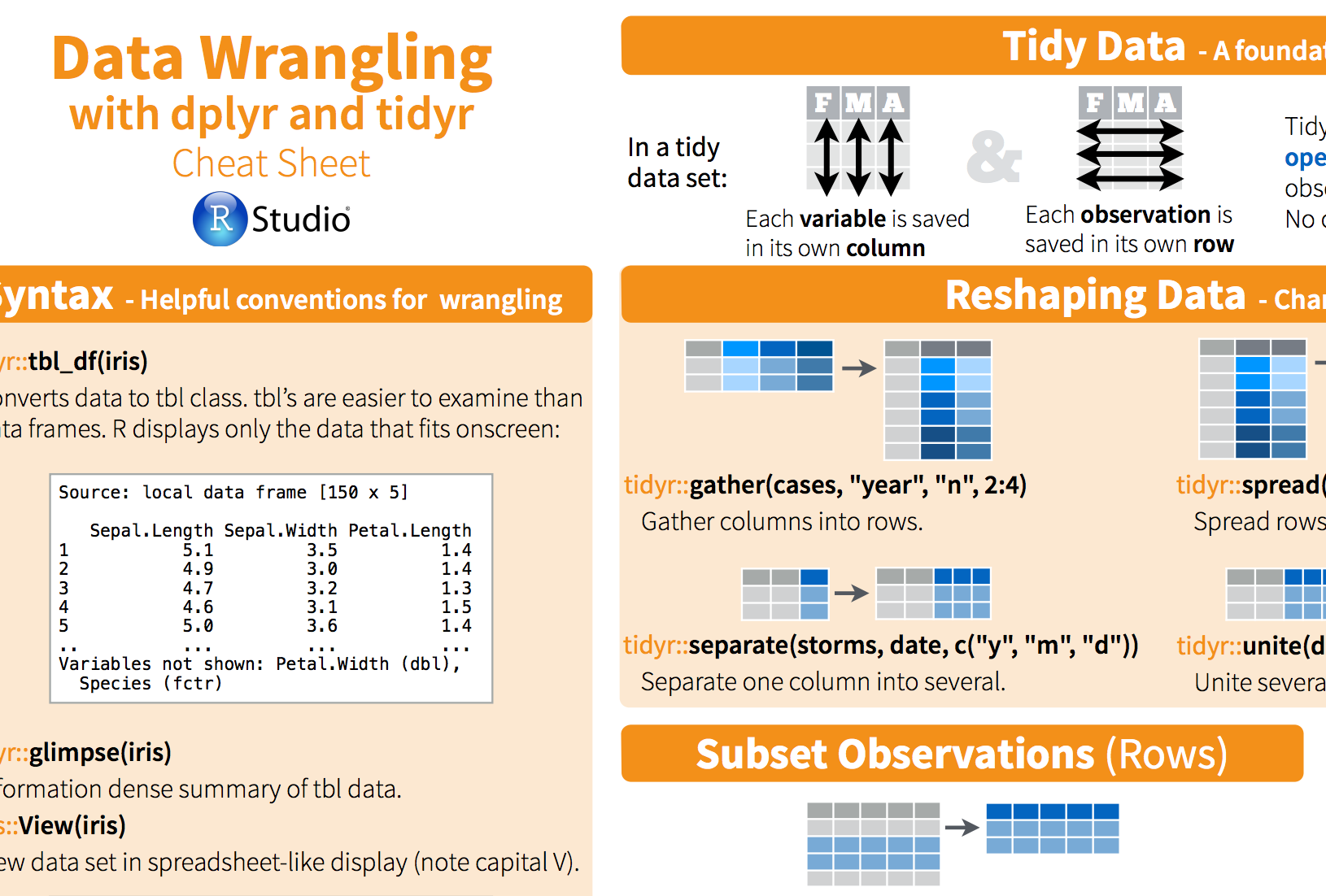Data wrangling with dplyr and tidyr cheat sheet tidy data foundation for wrangling in ma ma in tidy data set: each variable is saved in its own column syntax. This cheat sheet is a quick reference for data wrangling with Pandas, complete with code samples. By Karlijn Willems. By now, you’ll already know the Pandas library is one of the most preferred tools for data manipulation and analysis, and you’ll have explored the fast, flexible, and expressive Pandas data structures, maybe with the help of DataCamp’s Pandas Basics cheat sheet.
Complete List of Cheat Sheets and Infographics for Artificial intelligence (AI), Neural Networks, Machine Learning, Deep Learning and Big Data.
Arrange(.data, ) Order rows by values of a column or columns (low to high), use with desc to order from high to low. Arrange(mtcars, mpg) arrange(mtcars, desc(mpg)) addrow(.data.,.before = NULL,.a!er = NULL) Add one or more rows to a table. Addrow(faithful, eruptions = 1, waiting = 1) Group Cases Manipulate Cases EXTRACT VARIABLES ADD CASES. The majority of data wrangling cheat sheets were created as a handy guide for those using technical languages, such as R or Python, to prepare data. A data wrangling cheat sheet compiles all of the most common scripts used to prepare data for easy reference on one page. Data scientists spend less time second-guessing and simply look at their data wrangling cheat sheet to get the job done. Machine Learning: algorithm cheat sheet; Python for Data Science; TensorFlow; Keras; Numpy; Pandas; Data Wrangling; Data Wrangling with dplyr and tidyr; Scipy; Matplotlib; Data Visualization; PySpark; Big-O; About Stefan; To read the whole article, with each point explained and full illustrated, click here. For other related cheat sheets.
Content Summary
Neural Networks
Neural Networks Graphs
Machine Learning Overview
Machine Learning: Scikit-learn algorithm
Scikit-Learn
Machine Learning: Algorithm Cheat Sheet
Python for Data Science
TensorFlow
Keras
Numpy
Pandas
Data Wrangling
Data Wrangling with dplyr and tidyr
Scipy
Matplotlib
Data Visualization
PySpark
Big-O
Resources
Neural Networks

Artificial neural networks (ANN) or connectionist systems are computing systems vaguely inspired by the biological neural networks that constitute animal brains. The neural network itself is not an algorithm, but rather a framework for many different machine learning algorithms to work together and process complex data inputs. Such systems “learn” to perform tasks by considering examples, generally without being programmed with any task-specific rules.
Neural Networks Graphs
Graph Neural Networks (GNNs) for representation learning of graphs broadly follow a neighborhood aggregation framework, where the representation vector of a node is computed by recursively aggregating and transforming feature vectors of its neighboring nodes. Many GNN variants have been proposed and have achieved state-of-the-art results on both node and graph classification tasks.
Up the look of your game by using Blender models in Unreal Engine. Learn how with this simple importing guide. Unfortunately, Unreal Engine 4 works only with FBX, and only offers nice integration with plugins for Maya and 3DSMax. So, to use Blender, I had to learn how to configure it so I can use the models inside UE4 with no. Import from blender to unreal engine 4. Note: You will need Unreal Engine 4.23 or newer to get the tools to work. For more in-depth information on the topic, check out our Inside Unreal livestreams: Blender to Unreal tools, Part 1; Blender to Unreal Tools, Part 2; Blender to Unreal Tools, Part 3.
Machine Learning Overview
Machine learning (ML) is the scientific study of algorithms and statistical models that computer systems use to progressively improve their performance on a specific task. Machine learning algorithms build a mathematical model of sample data, known as “training data”, in order to make predictions or decisions without being explicitly programmed to perform the task. Machine learning algorithms are used in the applications of email filtering, detection of network intruders, and computer vision, where it is infeasible to develop an algorithm of specific instructions for performing the task.
Machine Learning: Scikit-learn algorithm
This machine learning cheat sheet will help you find the right estimator for the job which is the most difficult part. The flowchart will help you check the documentation and rough guide of each estimator that will help you to know more about the problems and how to solve it.
Scikit-Learn
Scikit-learn (formerly scikits.learn) is a free software machine learning library for the Python programming language. It features various classification, regression and clustering algorithms including support vector machines, random forests, gradient boosting, k-means and DBSCAN, and is designed to interoperate with the Python numerical and scientific libraries NumPy and SciPy.
Machine Learning: Algorithm Cheat Sheet
This machine learning cheat sheet from Microsoft Azure will help you choose the appropriate machine learning algorithms for your predictive analytics solution. First, the cheat sheet will asks you about the data nature and then suggests the best algorithm for the job.
Python for Data Science
TensorFlow

In May 2017 Google announced the second-generation of the TPU, as well as the availability of the TPUs in Google Compute Engine. The second-generation TPUs deliver up to 180 teraflops of performance, and when organized into clusters of 64 TPUs provide up to 11.5 petaflops.
Keras
In 2017, Google’s TensorFlow team decided to support Keras in TensorFlow’s core library. Chollet explained that Keras was conceived to be an interface rather than an end-to-end machine-learning framework. It presents a higher-level, more intuitive set of abstractions that make it easy to configure neural networks regardless of the backend scientific computing library.
Numpy
NumPy targets the CPython reference implementation of Python, which is a non-optimizing bytecode interpreter. Mathematical algorithms written for this version of Python often run much slower than compiled equivalents. NumPy address the slowness problem partly by providing multidimensional arrays and functions and operators that operate efficiently on arrays, requiring rewriting some code, mostly inner loops using NumPy.
Pandas
The name ‘Pandas’ is derived from the term “panel data”, an econometrics term for multidimensional structured data sets.
Data Wrangling


The term “data wrangler” is starting to infiltrate pop culture. In the 2017 movie Kong: Skull Island, one of the characters, played by actor Marc Evan Jackson is introduced as “Steve Woodward, our data wrangler”.
Data Wrangling with dplyr and tidyr
Pandas Data Wrangling Cheat Sheet
Scipy
SciPy builds on the NumPy array object and is part of the NumPy stack which includes tools like Matplotlib, pandas and SymPy, and an expanding set of scientific computing libraries. This NumPy stack has similar users to other applications such as MATLAB, GNU Octave, and Scilab. The NumPy stack is also sometimes referred to as the SciPy stack.
Matplotlib
matplotlib is a plotting library for the Python programming language and its numerical mathematics extension NumPy. It provides an object-oriented API for embedding plots into applications using general-purpose GUI toolkits like Tkinter, wxPython, Qt, or GTK+. There is also a procedural “pylab” interface based on a state machine (like OpenGL), designed to closely resemble that of MATLAB, though its use is discouraged. SciPy makes use of matplotlib. pyplot is a matplotlib module which provides a MATLAB-like interface. matplotlib is designed to be as usable as MATLAB, with the ability to use Python, with the advantage that it is free.
Data Visualization
R Cheat Sheets
PySpark
Big-O
Big O notation is a mathematical notation that describes the limiting behavior of a function when the argument tends towards a particular value or infinity. It is a member of a family of notations invented by Paul Bachmann, Edmund Landau and others, collectively called Bachmann–Landau notation or asymptotic notation.
Rstudio Data Wrangling Cheat Sheet
Resources
Big-O Algorithm Cheat Sheet
Bokeh Cheat Sheet
Data Science Cheat Sheet
Data Wrangling Cheat Sheet
Data Wrangling
Ggplot Cheat Sheet
Keras Cheat Sheet
Keras
Machine Learning Cheat Sheet
Machine Learning Cheat Sheet
ML Cheat Sheet
Matplotlib Cheat Sheet
Matpotlib
Neural Networks Cheat Sheet
Neural Networks Graph Cheat Sheet
Neural Networks
Numpy Cheat Sheet
NumPy
Pandas Cheat Sheet
Pandas
Pandas Cheat Sheet
Pyspark Cheat Sheet
Scikit Cheat Sheet
Scikit-learn
Scikit-learn Cheat Sheet
Scipy Cheat Sheet
SciPy
TesorFlow Cheat Sheet
Tensor Flow
Course Duck > The World’s Best Machine Learning Courses & Tutorials in 2020 Gfxbench metal iphone.
Tag: Machine Learning, Deep Learning, Artificial Intelligence, Neural Networks, Big Data
Related posts:
